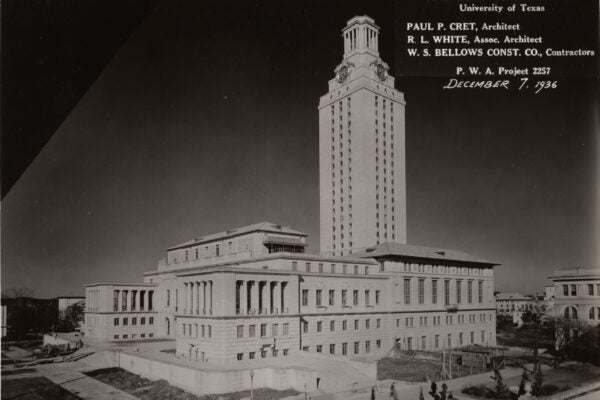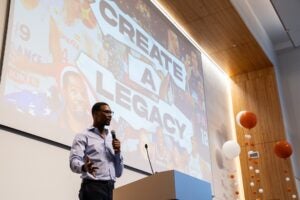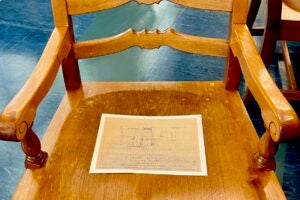The Book of Genesis tells a strange and interesting story about the building of a tower: People came together and built a tower “with its top in the heavens, and [said] let us make a name for ourselves…” God came down to see it and said, “This is only the beginning of what they will do.” God said if they could build this tower, then they could do anything. “… nothing that they propose to do will be impossible for them.”
As a University with audacious goals and ambitions, we might bookmark this passage. Were we, during the 1930s, trying to say, if we can build a 307-foot tower, we can do anything? Perhaps we were. There’s no question we were trying to make a statement, because there are much cheaper and easier ways of building a library.

To be clear, in the Bible story, that whole tower thing didn’t end well. It was an act of hubris and was grounds for punishment, so God scattered the uppity builders across the world and made them speak different languages to weaken and humble them, hence the name of the tower: Babel.
From the beginning, and at its core, tower building has been a flex of a civilization’s engineering prowess and a show of its collective labor. From the ancient Egyptians’ obelisks to Dubai’s Burj Khalifa, currently the tallest building in the world, a tower always has meant: Hey, check out what we can do!
Of course, power in and of itself doesn’t make a thing good. In J.R.R. Tolkien’s Middle Earth, the two towers of Sauron and Saruman were not places you wanted to be. Ditto for the notorious prison known as the Tower of London and any number of other Medieval fortresses.

But at universities, towers are a recurring device with a positive association. Stanford University, the University of California at Berkeley and the University of Pittsburgh’s Cathedral of Learning are a few other well-known examples.
Throughout history, towers have been used to mark city centers, places of authority, of permanence. They are gigantic stakes in the ground. They say, “Here we are.”
UT professor and former dean of the School of Architecture Larry Speck has thought a lot about this. For decades, he has taught the meaning of architectural forms. “They organize our lives. We respond to them in a very visceral way,” he says.
For a test question in his course on architectural meaning, Speck prompts his students to look at the UT Tower and tell him the meaning of the building. “They immediately figure out that in the whole history of architecture, the tower has been the center, the focus, the emblem that represents our community,” he says. It is unconscious for most people, but it is powerful in giving UT’s community identity. “And it’s done that beautifully for decades,” Speck says.
When President Robert Berdahl left UT to become chancellor at UC Berkeley, Speck was chosen to speak on behalf of the deans at his farewell party. “We were roasting him, and I did a little slideshow and said, ‘What is this decision you’re making, Bob! You’re going from a campus with this tower to the Berkeley campus, which has this little weenie tower that’s a rip-off of the Torre San Marco in Venice?’”

Every person connected to UT feels the Tower’s presence in a slightly different way. Kevin Eltife, chairman of the UT System Board of Regents, says, “I remember the Tower was the focal point of our whole existence on campus. Everything revolved around the Tower and the location. I just think the Tower is such a memory for everyone who ever walked on that campus. It is what we are known for. We take pride in it, and we are going to see that it’s properly restored.”
There are not many universities that have a single building that is instantly identifiable but also becomes a stand-in for the University.
Brent Stringfellow, associate vice president for campus operations and University architect, sees the Tower not just as the University’s core, but as its foundation. “We are looking at a future in the next few decades where UT is poised to do all kinds of amazing new things. Our campus can advance in ways that reflect all the dynamic aspects of the 21st century, but I see this as the anchor. This is what you build off of. Having that core really represent and be where the values of UT work out of is really important.” The Tower provides that center of gravity around which everything else can orbit.

“The Paul Cret master plan has gifted us an amazing legacy,” Stringfellow says. “And even when we haven’t been as attentive to it as we should have been, it still provides a really powerful sense of place. There are not many universities that have a single building that is instantly identifiable but also becomes a stand-in for the University.”
Speck’s parents enrolled at UT in 1938, when the Cret buildings were all new. The campus was amazing, he says. The education at that time, they later told him, was not. But the aspiration to greatness was clear to them, “and after a few generations of prospective faculty members, prospective presidents, prospective students all being drawn to that aspiration, it became a great university. Those buildings were a really important tool in making that happen.” Moreover, there was its prominence on the Austin skyline. When Speck would visit his aunt in Hyde Park, the Tower was framed perfectly by her south-facing window. “You know, I think that’s why I’m here,” he posits with a smile. “It may well be that Tower. It’s just so aspirational: This is the bigtime! This is an important place!”
The UT Tower is a symbol of power, no doubt, but it is not a monument to our own power or our own abilities; it is a monument to the power of learning—something made plain by the choice of the inscription on its façade, the words from the Book of John: “Ye shall know the truth, and the truth shall make you free.”

This story was excerpted from an article in the September/October 2023 issue of The Alcalde and expanded.




